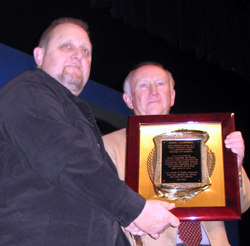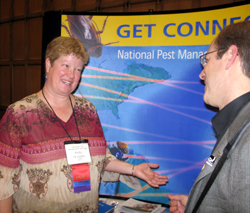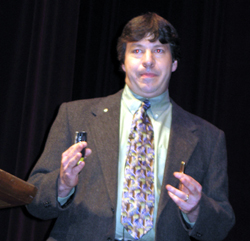Resurgence of Bed Bugs, Cockroaches Takes Center Stage at Purdue Conference
By
BRAD HARBISON
The Associated Press
Tuesday, January 10, 2006
 |
| Purdue's Gary Bennett (right) presents a plaque to Greg Campbell of Hatfield Pest Control, LaPorte, Ind., in appreciation of Campbell's efforts to promote continuing education throughout the pest control industry in Indiana. |
WEST LAFAYETTE, Ind. - This year marks the 70th anniversary of the Purdue Pest Management Conference, a milestone causing many people to reflect on the pest control industry's storied past. Ironically enough, two of the industry's earliest nemeses - bed bugs and cockroaches - have recently re-emerged as two of the industry's most challenging present-day pests. Much of the second day of the Purdue Pest Management Conference was devoted to these two pests.
Univar's Jim Delaney provided a review of new technologies in pest management - chemicals and equipment. Delaney noted that this is an interesting time for new product developments as manufacturers continue introducing new products and reformulating existing products, while more and more generic products are being introduced.
Noted industry consultant Austin Frishman retraced much of the industry's history, much of which has been recorded in Robert Snetsinger's The Ratcatcher's Child , and also looked ahead to the future by outlining seven challenges facing the industry.
- Foreign pests - Increased foreign travel is bringing in pests from other countries and taking our pests to other countries.
- Total loss of pesticides (due to regulatory decisions).
- Continuing consolidation on the PCO level - Fewer small owner/operators.
- Landscaping industry - Pest control companies looking to enter the lawn and landscape business should be prepared for a fight from landscape contractors, Frishman said.
- Hiring new employees - "We still don't do a good job getting good, young people interested in our industry," Frishman said.
- Technology from two standpoints: how do you introduce it in your company; and how not to get sued when DNA analysis shows cockroaches originated from your accounts.
- How you shift to survive - Which new services are a smart fit and profitable fit for your company.
 |
| NPMA's Kathy Heinsohn talks with Rose Pest Solutions' Russ Ives. |
NPMA Staff Entomologist Kathy Heinsohn and Cooper Pest Solutions Technical Director Rick Cooper then both gave comprehensive bed bug presentations. Heinsohn focused on the biology and behavior of bed bugs. Heinsohn also provided a historical perspective on bed bugs, noting that the WWII advent of DDT and maliathon nearly wiped out bed bugs completely, and left a 30-40 year research gap.
Cooper expanded on this thought about lack of research, noting that "we have more questions than answers about bed bugs." Cooper noted that the industry has two approaches to bed bug control: "hunt and peck" and island hopping.
The "hunt and peck" approach basically involves tearing apart a room completely and finding and eliminating every bed bug. Island hopping, on the other hand, involves targeting inspections and treatments to areas where people sleep. In other words, eliminate the majority of the bugs that feed on the host (people). In Cooper's experience, the latter approach is better. The major problem with the "hunt and peck" approach is that it requires significant man hours and the end result is that bed bugs will still not be entirely eliminated - meaning follow-up treatments will be likely. Island hopping also will require follow-up services, but it is less intrusive and solves the immediate threat.
 |
| Cooper Pest Solutions' Rick Cooper gave comprehensive presentations on bed bugs and cockroaches at the Purdue Pest Management Conference. |
Cooper also gave a presentation titled "Cockroaches: Down But Not Out."
Cooper discussed the biology and behavior of cockroaches and how scientific knowledge has been applied to practical applications for pest management professionals. Cooper also reviewed the history of residuals, the resistance issue and the use of baits. One of Cooper's key points was that a reason baits are failing is because pest control companies didn't use the technology as part of an integrated solution, but rather used baits as the primary cockroach solution. As a result, baits became the sole cockroach control tool for many technicians. In these situations, technicians had to be retrained on the proper inspection and use of multiple cockroach control products and strategies.
Other News & Notes
- The Purdue Pest Management Conference kicked off Monday with the grand opening of the exhibit hall featuring products and services from leading industry manufacturers. Conference attendees used this opportunity to learn about the latest industry innovations and to network with fellow professionals.
- Gary Bennett, coordinator and chair of the Purdue Pest Management Conference, presented a plaque to Greg Campbell, Hatfield Pest Control, LaPorte, Ind. Campbell served as chair of this year's conference planning committee. In addition, throughout his career Campbell has worked tirelessly to promote continuing education for pest management professionals in Indiana and has served as president of the Indiana Pest Management Association for two seperate terms.
- Bennett reported that about 800 people attended this year's conference, representing 35 states and five foreign countries.
- Sponsors of this year's event include: BASF Professional Pest Control; Bayer Environmental Science; Bell Laboratories; FMC Corporation; Indiana Pest Management Association; PCT Magazine; Pest Control Magazine; Syngenta Professional Products, Univar USA; and Zoecon Professional Products.
- Sponsors of speakers include: Action Pest Control; Batzner Pest Management; Dow AgroSciences; Forshaw Distribution; Holper Pest Control; Insect Technologies; NPMA; Orkin; Rose Pest Solutions; Southern Mill Creek Products of Ohio; Spraque Pest Solutions; Steritech; Terminix; Univar USA; McCloud Services; and Western Pest Services.
|